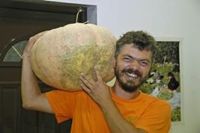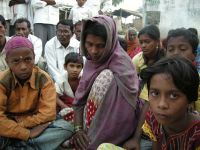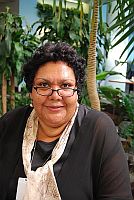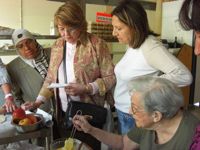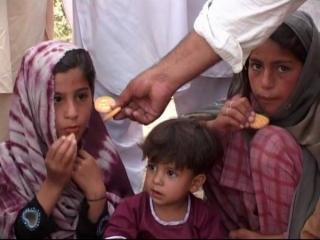Two articles from Oneworld.net reporting from war-torn northwestern Pakistan. May 27, 2009
WASHINGTON, May 27 (OneWorld.net) - As the conflict in northwestern Pakistan continues, humanitarian groups are reporting on rising numbers of uprooted people, 1.2 million vulnerable children, severe shortages of food, water, and services, lack of medical care for displaced pregnant women, and trapped civilians, some by Taliban landmines.
» People uprooted by the conflict in Pakistan. © bbcworldservice (flickr) Number of Displaced Pakistanis Grows as Does Need for Water, Food, and Services
People uprooted by the conflict in Pakistan. © bbcworldservice (flickr) Number of Displaced Pakistanis Grows as Does Need for Water, Food, and Services
from the International Rescue Committee
OneWorld.net's editors also suggest:
» Save the Children Assists Displaced Children in Pakistan
from Save the Children
» Pregnant Displaced Women Lack Facilities, Skilled Medics
from IRIN
» Fear Amid Reports of Landmine-Laying in Mingora
from IRIN
» Pakistan: Lift Swat Curfew for Trapped Civilians
from Human Rights Watch
May 27, 2009 WASHINGTON, May 26 (OneWorld.net) – Prevented from attending school due to ongoing violence in northwest Pakistan, 11-year-old Malalay speaks out about peace and her right to an education.
What's the Story?
 Pakistan children refugees © bartdegoeij (flickr)
Pakistan children refugees © bartdegoeij (flickr)
"I represent Swat, the Switzerland of the East, which, was once so beautiful, so peaceful and so full of life has now become a valley of violence, bloodshed, and denial of respect for humanity and values," said Malalay, speaking on behalf of her classmates at a peace conference organized by the international poverty alleviation group ActionAid and its local partner Citizen Rights and Sustainable Development. "O' the protector of human rights and justice, Come out! Stand by us! Give my books back! Give my pen back!" reads a poem Malalay wrote and used to address local elders.
Due to recent violence in northwest Pakistan, including Malalay's native Swat valley, hundreds of schools have been burned down. In addition, millions of people have been forced to flee the ongoing conflict between the Taliban and Pakistani military. Together, these factors are "causing girls to lose their right to an education," says ActionAid. (See the organization's full statement below.)
Pakistani Civilians Fleeing
The number of people fleeing and seeking to flee their homes in northwest Pakistan has spiked since a massive operation by the Pakistani military was launched on May 5 "to flush out Islamic fighters in Buner, Swat, and some areas in the nearby Dir district," according to the humanitarian news agency Inter Press Service.
People have been walking great distances in search of food, water, shelter, and medicine, reports Oxfam America. The aid organization has had to double its efforts as the total number of people seeking refuge from the violence recently passed 2 million, "making the crisis the greatest internal displacement of people in the country's history."
"Of the nearly 1.5 million people that have fled [the most recent bouts of conflict] so far, some 131,000 people are staying in camps, with more than 1.3 million staying in private accommodation, with host families or friends, and some in schools," notes the United Nations (UN) News Center.
The influx is putting extreme pressure on existing resources and the UN refugee agency has said it is crucial to establish new camps for those affected.
Some Still Trapped In Conflict Zone
While over a million civilians have escaped the fighting, hundreds of thousands remain trapped in the conflict zone, where "severe shortages of food, water, and medicine are creating a major humanitarian crisis," says Human Rights Watch.
Calling on Pakistani authorities to lift a 24-hour curfew on certain provinces, including Swat, the international monitor adds it has received "persistent reports of ongoing civilian casualties from Pakistani artillery shelling and aerial bombardment as desperate civilians break the curfew in search of food and water or to flee hostilities."
"Pakistani armed forces and Taliban militants should take all necessary precautions to avoid civilian casualties in fighting in Pakistan's volatile Swat valley and adjoining areas of the North West Frontier Province," appealed HRW amid earlier reports that the Taliban is preventing civilians from leaving the combat areas and using them as human shields.
"Hundreds of thousands of people are still trapped," said the International Rescue Committee (IRC), calling for "a humanitarian corridor so people can flee to safety and vital aid can be delivered."
U.S. Response
U.S. Secretary of State Hillary Clinton announced last week plans to send $110 million in aid to displaced Pakistanis, reports Refugees International (RI).
While the funds will help aid agencies respond quickly to the current situation, RI expressed concern that the funding is "insufficient compared to the scale of the crisis." Says RI Advocate Patrick Duplat: "the U.S. must provide many more resources" to support and protect Pakistanis forced to flee their homes.
Background: Repression and Conflict in Northwest Pakistan
"Since 2007, the Taliban have imposed their authority in Swat and adjoining areas through summary executions -- including beheadings -- of state officials and political opponents, public whippings, and large-scale intimidation of the population," writes HRW. "Girls' schools have been shut down, women have not been allowed to leave their homes unless escorted by male family members, polio immunization programs were halted, and nongovernmental organizations were expelled."
In early April, Pakistani President Asif Ali Zardari signed a peace accord increasing the Taliban's control over numerous districts within the NWFP and allowing them to establish their version of Islamic law in Swat in exchange for laying down their arms.
Two weeks ago, however, Prime Minister Yusuf Raza Gilani "declared an end to the peace deal with the Taliban, citing multiple violations of the deal by the Taliban and vowing to 'eliminate them,'" explains HRW.
Take Action
The U.S.-based group Islamic Relief Worldwide launched an initial $750,000 emergency appeal to assist the nearly 2 million people affected by the violence and growing humanitarian crisis in Pakistan. "Assistance will include the provision of emergency aid such as blankets, clothing and cooking sets, supplies of clean water, and psychosocial support for traumatized children," writes the organization. Click here to read more and get involved.
_________________________________________________________________________________________________________________________
Malalay: A Pakistani Girl Speaks Out in Swat
From: ActionAid
Ongoing war in Swat displaced more than 1 million people in the past six weeks. Families are forced from their homes due to the conflict. And when they leave, they lose much more than the roof over their head. They lose their ability to make a living, access to food and other assets they might have stored, and the ability to predict what tomorrow might hold for their children.
This violence and the increasing pressure brought to bear by the Taliban and other extremists in Swat is causing girls to lose their right to an education. Hundreds of schools were burnt down in the recent violence. The war is taking shape as a war on female education. In the face of this, Malalay, an 11-year-old girl from Swat - and a gifted student - speaks out.
"I represent Swat, the Switzerland of the East, which, was once so beautiful, so peaceful and so full of life has now become a valley of violence, bloodshed and denial of respect for humanity and values," says Malalay. "My valley is turning into ruins and my school is threatened to be turned into ashes."
ActionAid in collaboration with Citizen Rights and Sustainable Development (CRSD) organized a peace conference with community groups from Swat and other conflict-prone areas in Pakistan to discuss and highlight the effects of extremism and the on-going war on terror. Malalay spoke on behalf of her classmates as this conference.

Fhaheen Bibi, 25, stands outside a temporary shelter with a baby.
Copyright © Warrick Page/ Panos Pictures/ ActionAid
Malalay whose name is derived from a heroic folk lore character, gave moving account of her life as a girl in Swat. She shared her fears and concerns about the future which seem to hold nothing but bleakness. She explained that her community has complied with all the Taliban's orders but they still continue to harrass the community.
"Every child of my age in the area is terrified. We are not allowed to go to schools, when they asked us not to go to schools, we stopped going there," she added. "Yet, they torched our schools. We couldn't go out to play."
"I want to become a doctor. I want to tell all the extremist elements that if they deny female education, where would they send their own daughters for medical treatment," Malalay said.
Malalay is also fearful for her teachers who are threatened everyday by these militant elements.
"My teachers have dedicated themselves for the mission of imparting education and yet, these forces have threatened to kill them and forced them to stay at home," she added
"My school has 62 teachers and around 700 children are studying in the school and it's been weeks that no educational activity has taken place in our schools. I won a quiz competition on my last day at school and I was so happy that I beat all the other students of my age, but now I dread that I would never be able to go to school, participate in quizzes and win prizes for my abilities," Malalay said, with tears in her eyes.
Malalay is a very intelligent girl and has a very good understanding of what is happening in her community. Her love for her homeland and her anguish on the current situation is very obvious from this poem, which she wrote herself to address elders and the people in power.
Education is my basic right
My books have been burnt
My pen has been broken
My school has been torched
O' the protector of human rights and justice,
Come out! Stand by us!
Give my books back!
Give my pen back!
I am the daughter of the Eve!
I'm a mother, I' m a sister, I' m a daughter...
I am an honorable part of this global village...
Is there anyone to hear my voice, to hear Swat??
Help us and protect us!
Malalay inspires people with her conviction, from the originality of thoughts. Her words are source of strength, encouragement and hope. She vows to continue speaking out against the violation of girls' rights, especially their right to education, as she believes education is the only way to prosperity and better future.
Please join ActionAid as it assesses the current situation for hundreds of thousands of people fleeing northwest Pakistan due to a recent rash of violence between the government and Taliban forces.
OneWorld TV: Humanitarian Crisis in Pakistan's Camps
 In her early twenties, Trinephi's curiosity about her roots started calling her. She went to Hong Kong, where she worked as an interpreter in a Vietnamese refugee camp. By this time, hundreds of thousands of Vietnamese were on the move in wooden boats, most of them spending months if not years in camps from Malaysia to Australia.
In her early twenties, Trinephi's curiosity about her roots started calling her. She went to Hong Kong, where she worked as an interpreter in a Vietnamese refugee camp. By this time, hundreds of thousands of Vietnamese were on the move in wooden boats, most of them spending months if not years in camps from Malaysia to Australia. 